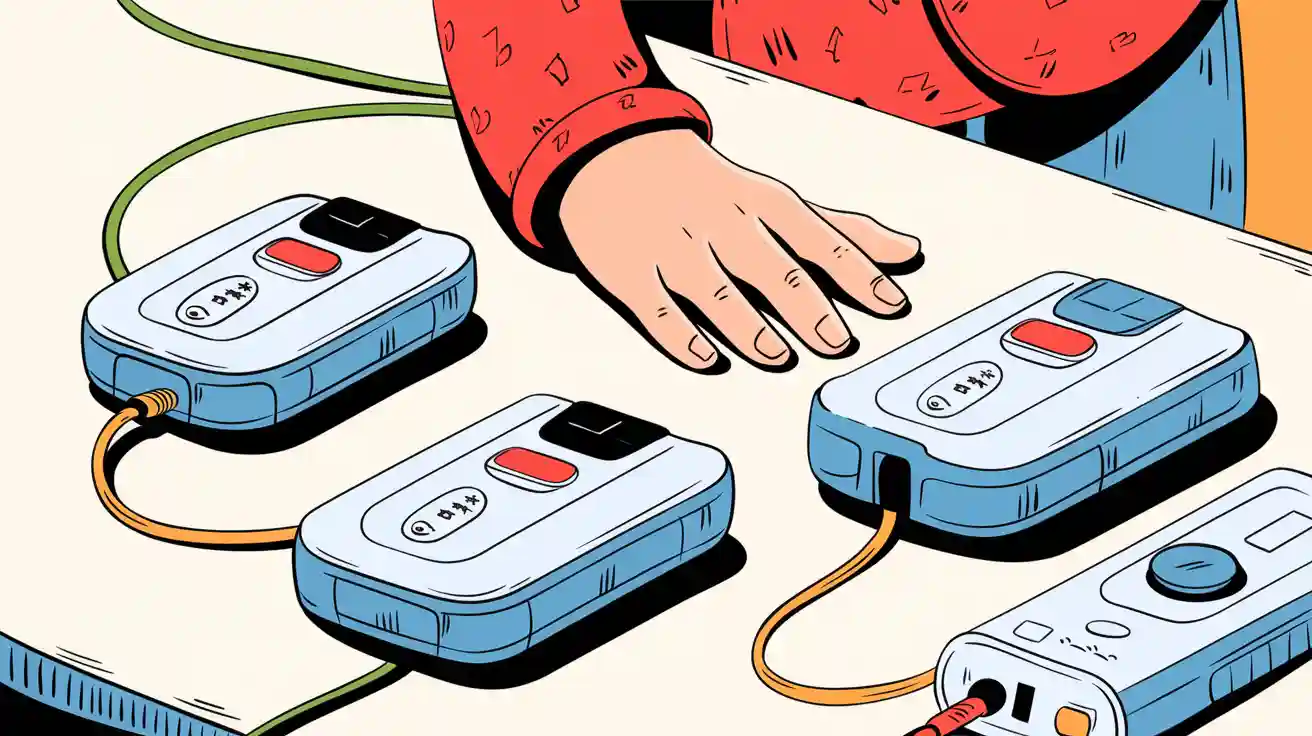
You see leading portable oxygen concentrators in 2025, such as the Inogen Rove 6, CAIRE FreeStyle Comfort, and Philips SimplyGo Mini, setting new standards with lightweight designs and advanced lithium battery technology. These models deliver long battery life, supporting oxygen therapy even in demanding medical, industrial, and infrastructure settings. Portability and reliability influence your purchasing decisions, as shown by the global market’s rapid growth and the shift toward home and mobile care.
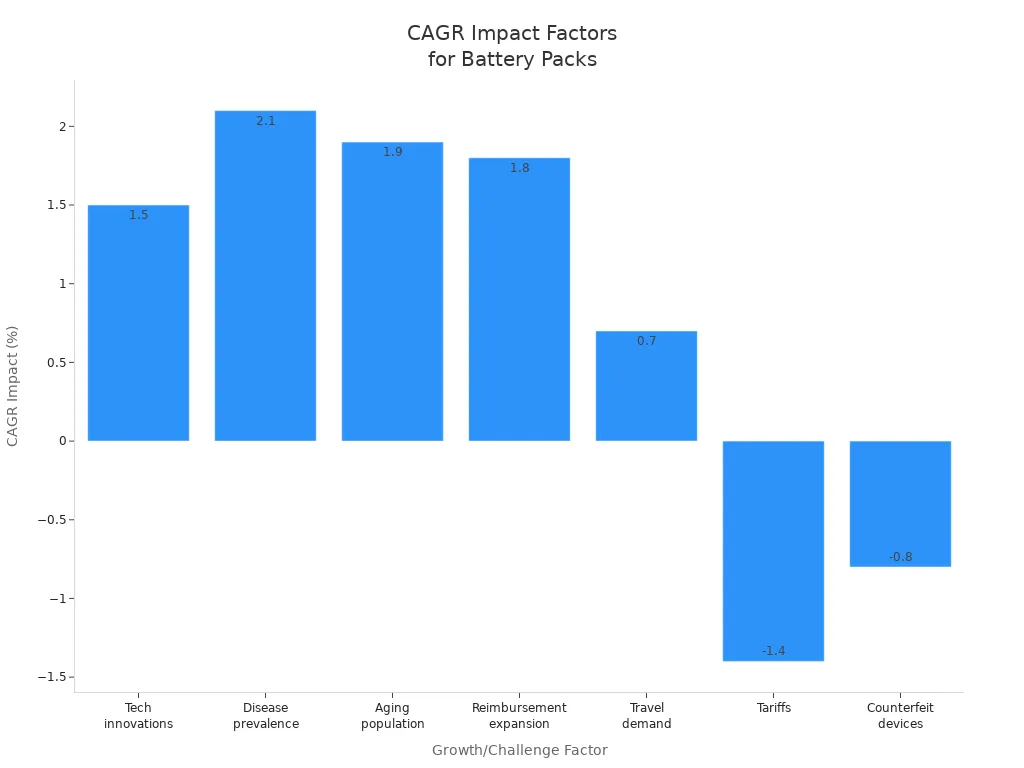
When you compare Portable Oxygen Concentrator Battery Pack Design side by side, you ensure the right fit for operational efficiency and patient outcomes.
Key Takeaways
Choose portable oxygen concentrators with advanced lithium battery technology for longer battery life, lighter weight, and reliable oxygen delivery.
Balance battery life and portability by selecting models that fit your specific needs, whether for travel, home care, industrial use, or emergency backup.
Look for safety certifications like UN38.3, IEC 62133, and FAA approval to ensure compliance and safe operation in medical and industrial settings.
Prioritize easy battery replacement and user-friendly features such as LED indicators and quick charging to maintain continuous oxygen therapy.
Match battery packs to your oxygen flow requirements and operational environment to optimize performance, efficiency, and patient outcomes.
Part 1: Top Picks
1.1 Leading Models
You need portable oxygen concentrators that deliver reliable performance and long battery life for demanding environments. In 2025, industry reviews highlight several models that stand out for their lithium battery technology, robust design, and operational flexibility.
Inogen Rove 6: Delivers efficient oxygen therapy with battery life ranging from 6 to 12.75 hours. Approved for air travel, this model remains small and light, supporting extended use during long shifts or travel.
Inogen One G4: Weighs only 2.7 lbs, offers reliable oxygen delivery, and provides up to 5 hours of battery life. You can easily operate it in medical, industrial, or infrastructure settings.
Philips Simply Go: Offers both continuous and pulse flow modes, backed by a trusted brand. The mid-range battery life suits facility use and mobile care.
Oxygo Fit: Lightweight at 2.8 lbs, supports up to 5 hours of battery life, and is designed for active users in healthcare or robotics.
Invacare Platinum Mobile: Features a rugged, water-resistant design with up to 5 hours of battery life, ideal for outdoor or industrial applications.
You can compare these models side by side to identify which portable oxygen concentrator best fits your operational needs.
Model | Key Features | Battery Life | Pros | Cons | Best For |
|---|---|---|---|---|---|
Inogen Rove 4 | Lightweight (<3 lbs), pulse dose 1-4, FAA approved, quiet operation | Up to 5+ hours (extended battery) | Extremely lightweight, long battery life, travel-friendly | Pulse dose only | Active individuals needing lightweight, reliable POC for daily use and travel |
Inogen Rove 6 | Higher oxygen output (6 pulse dose settings), FAA approved, very quiet (37 dB) | Up to 12 hours (extended battery) | Exceptional battery life, high oxygen output, very quiet | Pulse dose only | Users requiring extended oxygen therapy and quiet operation |
Oxlife Liberty 2 | Dual pulse and continuous flow oxygen delivery, FAA approved | Not specified | Continuous flow and pulse dose, high oxygen output | Larger and heavier | Users needing versatile oxygen delivery options |
Inogen One G4 | Ultra-compact, pulse dose (3 settings), FAA approved | Up to 2.7 hours (single battery), 5 hours (double) | Affordable, reliable, compact and lightweight | Short battery life | Users prioritizing portability and affordability |
Philips Simply Go | Continuous flow and pulse flow, FAA approved | 3 hours (pulse), 54 mins (continuous) | User-friendly, reliable, consistent performance | Mid-range battery life | Users seeking easy operation and consistent performance |
Oxygo Fit | Pulse dose (3 settings), lightweight (2.8 lbs), FAA approved | Up to 5 hours | Supports active lifestyle, compact, dependable | Limited flow settings | Active users needing oxygen on the go |
Invacare Platinum Mobile | Pulse dosing (1-5 settings), FAA approved, rugged design | Up to 5 hours | Durable, reliable, good for long-term use | Heavier, less modern interface | Users needing durable, robust POC for frequent use |
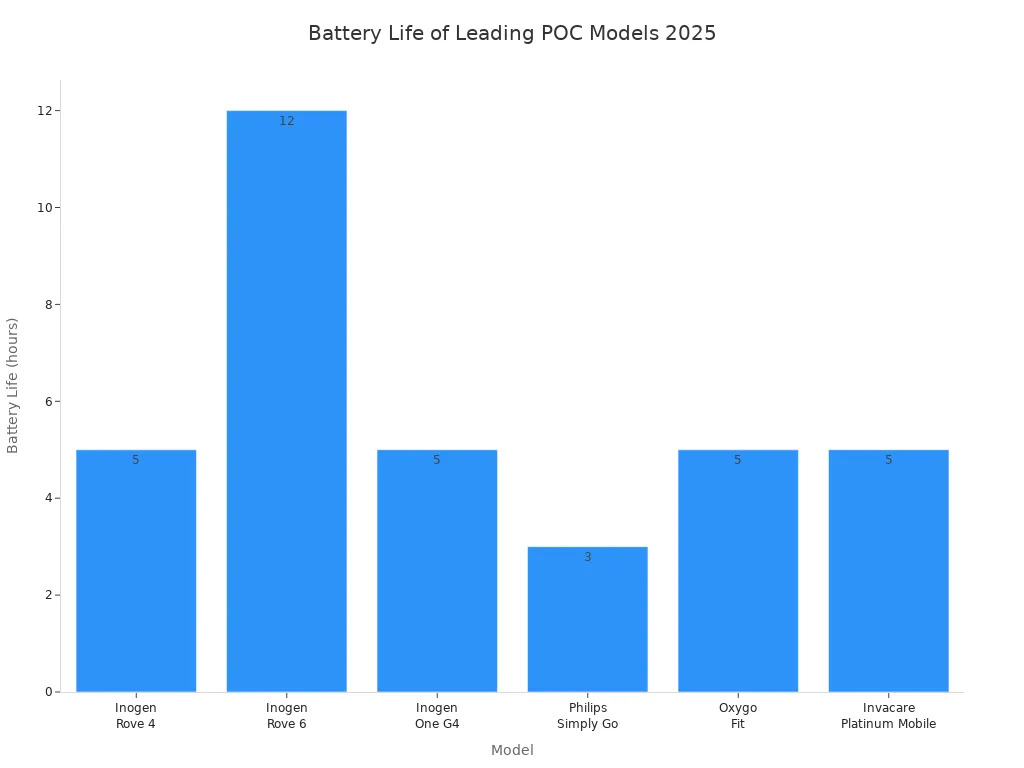
1.2 Key Features
You should focus on several key features when evaluating portable oxygen concentrator battery packs for B2B applications.
Runtime varies by model. Single batteries typically provide 3–7 hours, while extended batteries can reach up to 13 hours. You must balance longer battery life with added weight for mobility.
Rechargeability matters. Leading models use lithium-ion or lithium-polymer chemistries, offering high energy density and long cycle life.
Safety certifications such as UN38.3, IEC 62133, and FAA/TSA approval ensure compliance for travel and facility use.
Built-in protection features, including thermal, overcharge, and short-circuit safeguards, enhance safety in medical, robotics, and industrial sectors.
User-friendly design features like easy battery swaps, LED indicators, and robust connectors improve operational efficiency.
Dual battery systems and backup options, such as portable power stations and vehicle charging kits, support uninterrupted oxygen therapy during emergencies or travel.
Tip: You should consider custom battery solutions for OEMs, which offer precise voltage tuning, smart features, and compatibility with infrastructure and security systems.
You can optimize your portable oxygen concentrator selection by matching battery life, lithium battery technology, and safety features to your specific operational requirements.
Part 2: Battery Pack Basics
2.1 What Is a Portable Oxygen Concentrator Battery Pack?
You rely on a portable oxygen concentrator battery pack to power advanced oxygen therapy devices in diverse environments. This battery pack uses lithium-ion or lithium-polymer chemistry, which delivers high energy density and long cycle life. You find these packs in medical, robotics, security system, infrastructure, consumer electronics, and industrial sectors. The battery pack supplies the energy needed for your portable oxygen concentrator to generate medical-grade oxygen, supporting patients and staff wherever mobility is essential.
You can expect modern battery packs to feature lightweight construction, robust safety mechanisms, and user-friendly interfaces. Most leading models allow you to swap batteries quickly, minimizing downtime during critical operations. These packs often include LED indicators, thermal protection, and overcharge safeguards, ensuring reliable performance in demanding settings.
Note: Lithium battery technology enables you to achieve longer runtimes and greater portability, which are vital for uninterrupted oxygen therapy and operational efficiency.
2.2 Why Battery Performance Matters
Battery performance directly impacts the reliability and usability of your portable oxygen concentrator. You need consistent power to deliver oxygen therapy, whether in a hospital, industrial site, or during patient transport. Longer battery life means you can provide relief for breathing problems and support for covid-19 recovery without frequent recharging. Fast charging and the ability to charge while in use further enhance operational flexibility.
The following table highlights how battery performance varies among top models:
Feature | Inogen Rove 4 | Inogen Rove 6 | Other Models (Examples) |
|---|---|---|---|
Battery Life (Standard) | Up to ~3 hours | Up to ~6.25 hours | 3.5 to 4.5 hours (varies) |
Battery Life (Extended) | Up to ~5 hours 49 minutes | Up to ~12.75 hours | Up to 4 hours (continuous flow) |
Charging Time | 3.25 hours (standard), 6 hours (extended) | 4 hours (standard), 8 hours (extended) | 2-3 hours (varies) |
Weight | Under 3 pounds | About 4.8 pounds | 5.9 to 8.6 pounds (with battery) |
Charging While in Use | Yes | Yes | Yes |
You see that longer battery life and lighter weight give you more freedom and independence. These features reduce anxiety about power depletion and help you maintain continuous oxygen therapy. The ability to charge while using the device adds convenience and reliability.
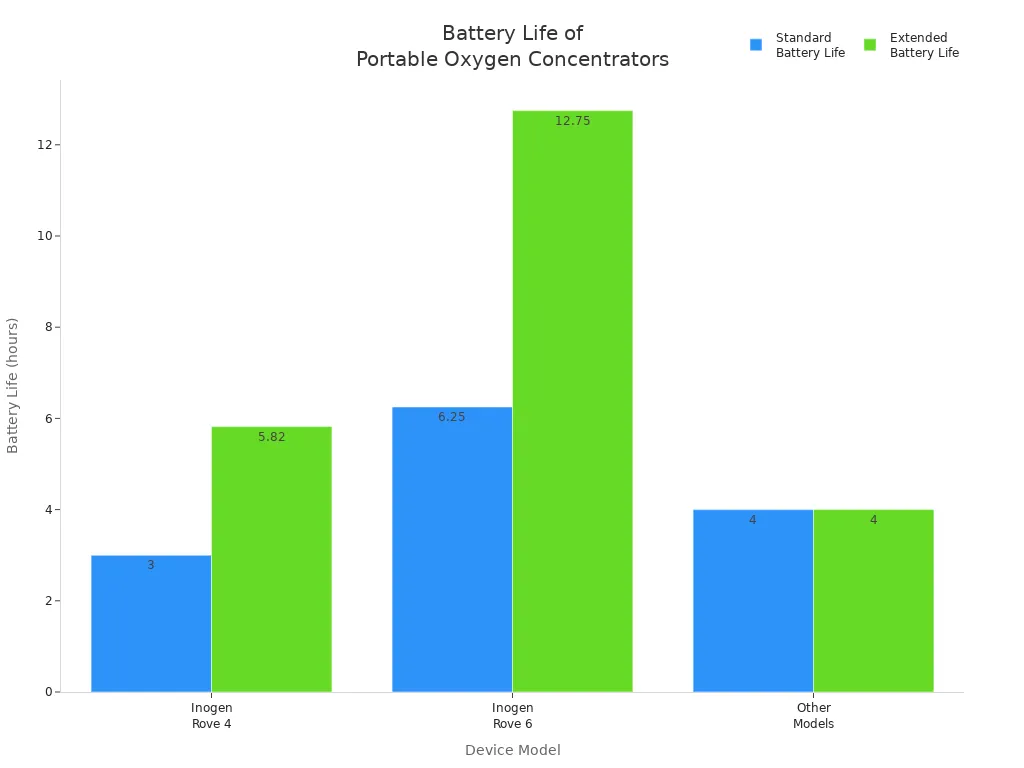
You benefit from these advancements by delivering the benefits of oxygen therapy to more patients, improving outcomes, and ensuring compliance with safety standards. Reliable battery performance supports your mission to provide uninterrupted care and operational excellence.
Part 3: Comparison Overview

3.1 Battery Life
You rely on battery life as a critical factor when selecting portable oxygen concentrators for your organization. The duration of operation directly affects patient care, workflow efficiency, and compliance with travel regulations. Most leading models in 2025 use advanced lithium-ion or lithium-polymer battery chemistries, which provide high energy density and long cycle life. You see battery life ranging from as little as 1.5 hours for ultra-light models to up to 16 hours for extended battery packs at the lowest oxygen delivery settings.
Model | Lithium Battery Chemistry | Battery Life (Standard/Extended) | Notes on Oxygen Delivery & Features |
|---|---|---|---|
CAIRE FreeStyle Comfort | Lithium-ion | 8 (8-cell) / 16 (16-cell) | Pulse dose, FAA approved, quiet operation |
Inogen One G5 | Lithium-ion | Up to 6.5 / 13 (double battery) | Pulse dose, high oxygen output, travel-friendly |
Inogen One Rove 6 | Lithium-ion | 6 (single) / 12.75 (double) | Pulse dose, high oxygen output, very quiet |
AirSep Focus | Lithium-polymer | 1.5 per battery / 7 (with AirBelt) | Ultra-light, pulse dose, wearable AirBelt option |
Philips SimplyGo Mini | Lithium-ion | 4.5 (standard) / 9 (extended) | Pulse dose, compact, user-friendly |
Oxlife Liberty 2 | Lithium-ion | 4.5 (pulse) / 4 (continuous) | Pulse & continuous flow, high oxygen output |
VARON VL-1/VL-2 | Lithium-ion | 2 to 8 | User-replaceable, extended use, pulse dose |
Belluscura X-PLOR | Lithium-ion | 4.5 (standard) / 8 (extended) | Pulse dose, lightweight, modular battery |
CAIRE SeQual Eclipse 5 | Lithium-ion | 2 (continuous) / 5 (pulse) | Pulse & continuous flow, robust design |
You can see that extended battery options and double batteries significantly increase usage time, supporting uninterrupted oxygen therapy in medical, industrial, and infrastructure settings.
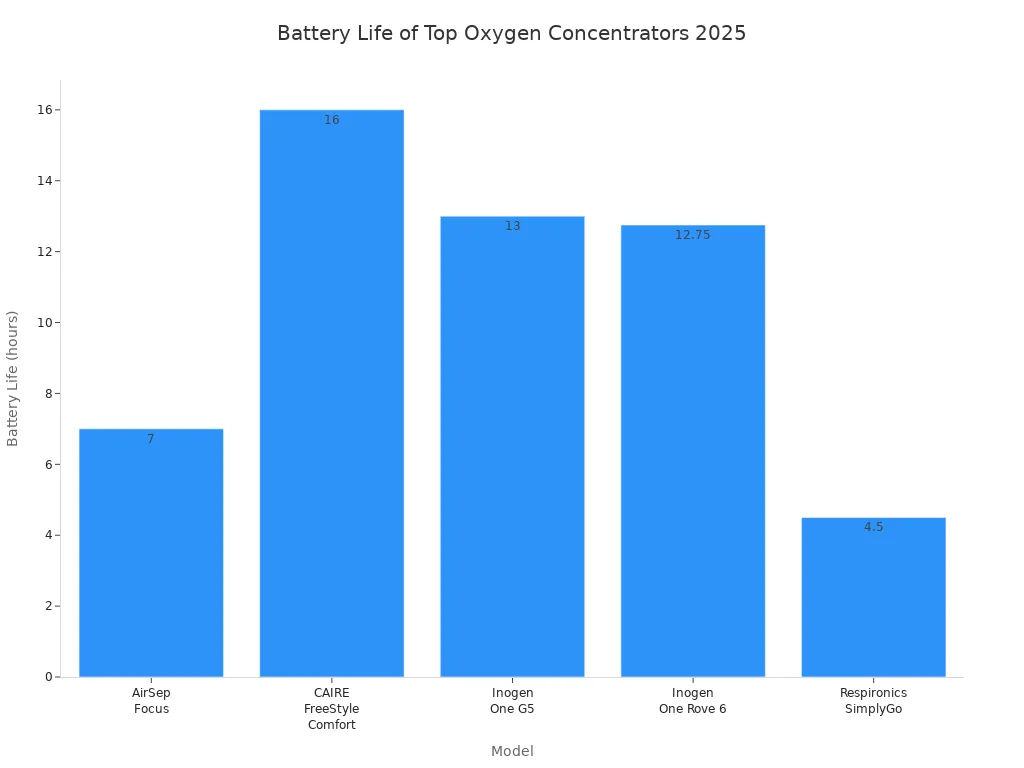
3.2 Weight and Portability
Weight and design play a major role in how easily you can deploy portable oxygen concentrators across different environments. Lighter models enhance portability, making them ideal for mobile healthcare teams, robotics, and emergency response. Heavier models often provide longer battery life or continuous oxygen delivery, but they may reduce ease of transport.
Model | Weight (lbs) | Battery Life (Extended) | Portability Impact |
|---|---|---|---|
Inogen Rove 4 | Under 3 | Extremely lightweight, ideal for travel and active users. | |
Inogen Rove 6 | 4.8 | Up to 12.75 hours | Slightly heavier, balances long battery life with manageable weight. |
Oxlife Liberty 2 | 8.6 (with battery & case) | Up to 4.5 hours (pulse) | Heavier, less portable, offers more oxygen delivery options. |
Drive DevilBiss iGo2 | 5.9 | Up to 3.5 hours (pulse) | Moderate weight, moderate battery life, rugged design. |
You must balance battery life and oxygen delivery needs with portability preferences for your staff and patients.
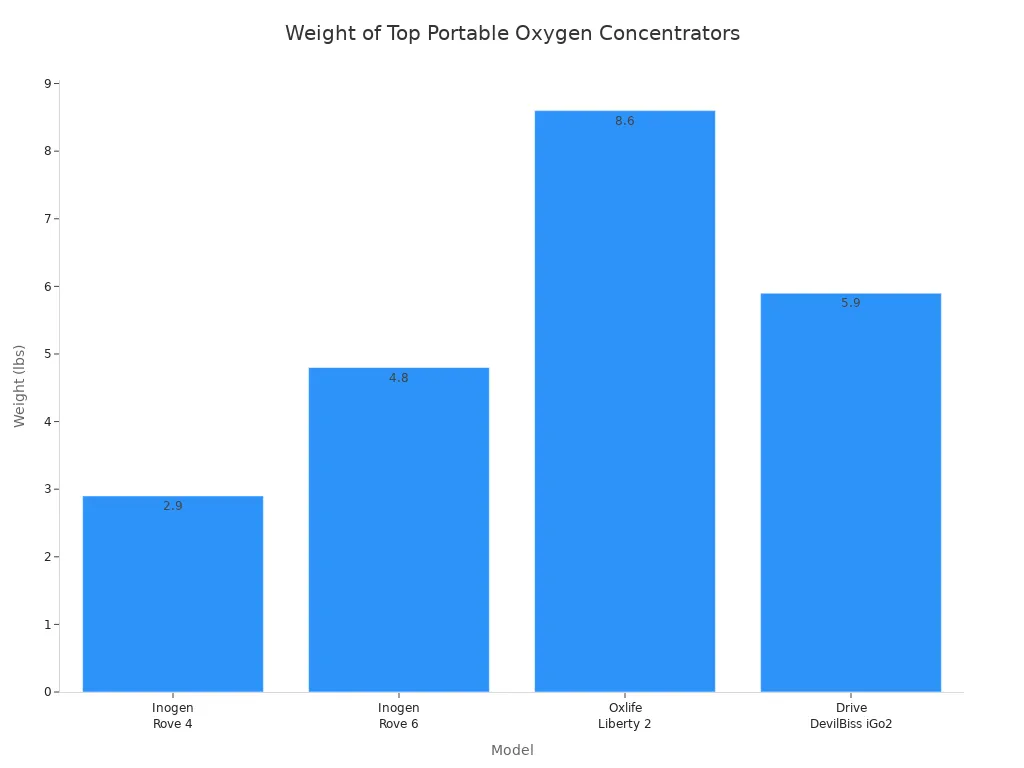
3.3 Charging Time
Charging time affects operational readiness and workflow efficiency. Most portable oxygen concentrator battery packs require between 1 to 8 hours for a full charge, depending on battery capacity, charger output, and lithium battery technology. Some models, such as the SG02L, feature rapid charging and can reach full capacity in about 1 hour. You should always consult manufacturer guidelines for specific charging times, especially when planning for emergency backup or continuous use in medical, robotics, or industrial sectors.
Quick charging options reduce downtime and support uninterrupted oxygen delivery during critical operations.
3.4 Compatibility
Compatibility ensures you can use battery packs across multiple portable oxygen concentrator models, optimizing inventory and reducing procurement complexity. Some battery packs, like the 8 Cell Battery for NT-03 & NT-05, work with a wide range of devices, including NT-01, NT-02, NT-03, NT-05, NT-06, and NT-08G. You benefit from broad compatibility, especially when managing fleets of devices in healthcare, security systems, and infrastructure applications.
8 Cell Battery Duration (approx.) | 16 Cell Battery Duration (approx.) | |
|---|---|---|
1 Liter | ~3 hours 20 minutes | ~6 hours 40 minutes |
2 Liters | ~3 hours | ~6 hours |
3 Liters | ~2 hours 15 minutes | ~4 hours 30 minutes |
4 Liters | ~2 hours | ~4 hours |
5 Liters | ~1 hour 45 minutes | ~3 hours 30 minutes |
You should verify CE certification and FAA approval for all battery packs to ensure compliance with regulatory standards in medical and industrial sectors.
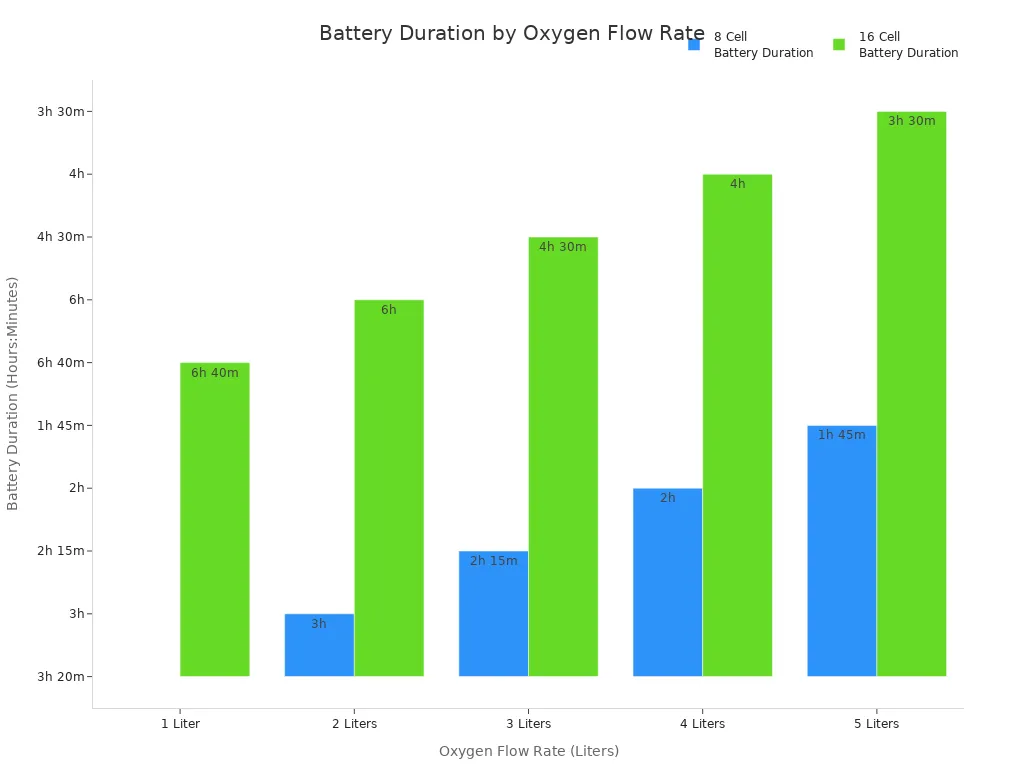
3.5 Special Features
You find that leading portable oxygen concentrators offer advanced features such as modular battery packs, dual oxygen delivery modes, and smart charging systems. Lithium battery technology supports these innovations, providing reliable power for high oxygen output and flexible oxygen output and delivery settings. You can select models with user-replaceable batteries, LED status indicators, and rugged designs for deployment in medical, robotics, security system, infrastructure, consumer electronics, and industrial sectors.
Tip: You should prioritize models with extended battery life, rapid charging, and broad compatibility to maximize operational efficiency and patient outcomes.
Part 4: Portable Oxygen Concentrator Battery Pack Design
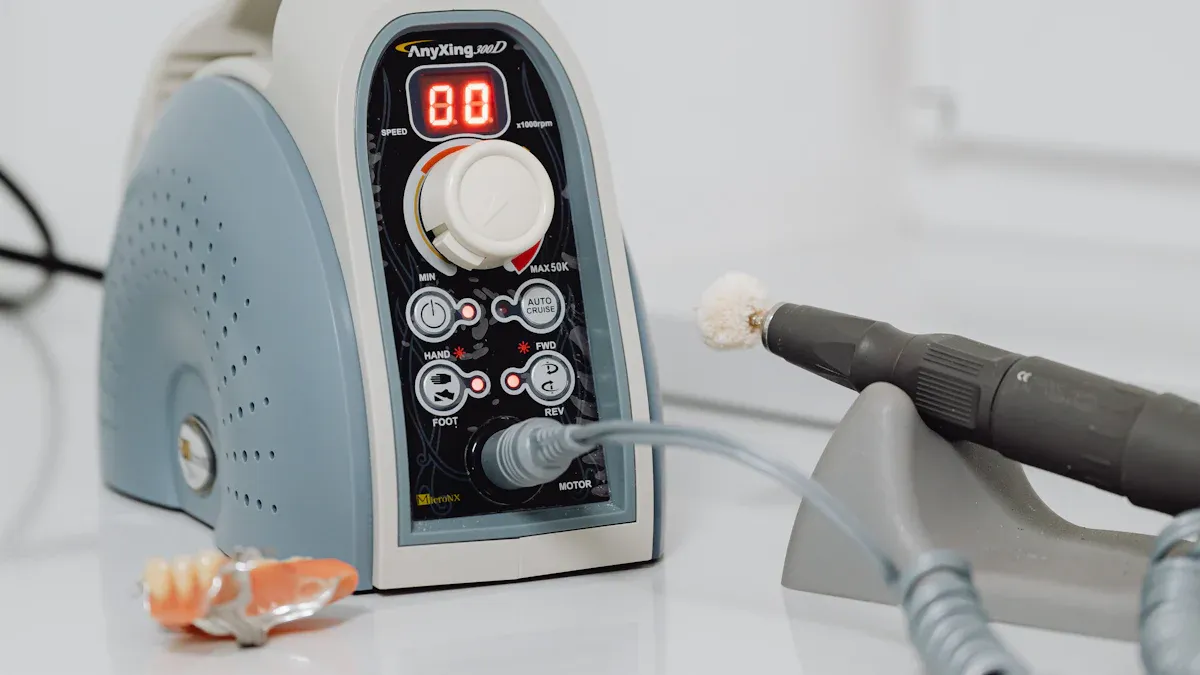
4.1 Lithium Battery Technology
You depend on advanced lithium battery technology to achieve reliable performance in portable oxygen concentrator battery pack design. Top models use lithium-ion chemistries such as LiFePO4 (Lithium Iron Phosphate), NMC (Nickel Manganese Cobalt Oxide), LCO (Lithium Cobalt Oxide), LMO (Lithium Manganese Oxide), LTO (Lithium Titanate), solid-state, and lithium metal. Each chemistry offers unique benefits for medical, robotics, security system, infrastructure, consumer electronics, and industrial sectors. For example, LiFePO4 provides excellent thermal stability and long cycle life, while NMC delivers high energy density for extended runtime. LCO is compact and lightweight, making it ideal for portable oxygen concentrator battery pack design where size and weight matter.
Manufacturers like Large Power enhance battery safety and durability by integrating proprietary technologies that protect against heat, moisture, and pressure. These batteries undergo rigorous testing to meet FDA and international standards, ensuring compliance and reliability. Pulse flow oxygen delivery technology further extends battery life by supplying oxygen only during inhalation, reducing power consumption compared to continuous flow systems. You can explore battery management systems (BMS) for additional safety and performance features in portable oxygen concentrator battery pack design. Learn more about BMS here.
Tip: Always consider the operating environment. Cold temperatures reduce efficiency, while high humidity can cause blockages. Store batteries at 50% charge in stable conditions between 41°F and 104°F, with 40–60% relative humidity.
Ease of Replacement
You benefit from portable oxygen concentrator battery pack design that prioritizes easy battery replacement. Leading models feature user-friendly compartments and release mechanisms, allowing you to swap batteries without tools or technical skills. The process typically involves powering down the device, unlocking the battery compartment, removing the old battery, inserting the new one, and securing the latch.
Model | Battery Replacement Ease | Tools Required | Skills Required | Replacement Steps Summary |
|---|---|---|---|---|
Philips Respironics SimplyGo | Easy | None | Basic user | Turn off, unlock compartment, swap battery, lock, power on |
Philips Respironics SimplyGo Mini | Easy | None | Basic user | Turn off, press release button, slide out, insert new, release, power on |
Inogen One G3 | Easy | None | Basic user | Turn off, press release, slide out, insert new, release, power on |
CAIRE FreeStyle Comfort | Easy | None | Basic user | Turn off, unlock compartment, swap battery, lock, power on |
Note: Always follow manufacturer instructions for battery replacement. Proper handling supports safety and maximizes device uptime in medical and industrial settings.
You should recycle used lithium batteries responsibly. Programs like Call2Recycle offer thousands of drop-off locations at major retailers. Prepare batteries by bagging or taping terminals, and never dispose of them in regular waste to prevent safety hazards.
Pros and Cons
Model Comparison
You need to evaluate each portable oxygen concentrator battery pack by weighing its strengths and weaknesses. The following table summarizes the main pros and cons of leading models, focusing on battery life, portability, and unique features. This comparison helps you match the right device to your operational needs in medical, robotics, security system, infrastructure, consumer electronics, and industrial sectors.
Model | Pros | Cons |
|---|---|---|
Inogen One G4 | Very lightweight and compact; easy-to-use interface; remote monitoring via Inogen Connect app | Short battery life; low max oxygen output; recharge time over 3 hours |
Philips Respironics SimplyGo | Light for continuous flow; quick recharge; high oxygen output; durable with rolling cart | Louder than pulse-flow models; higher cost; less user-friendly controls |
Philips SimplyGo Mini | Compact and lightweight; long battery life; multiple flow settings; travel-friendly; DC power option | Long recharge time; higher noise level; higher price |
CAIRE Freestyle Comfort | Extended battery life (up to 16 hours); ergonomic design; smart delivery features; telehealth support | Moderate max oxygen output; fewer online reviews |
Note: All models use advanced lithium-ion battery technology, ensuring high energy density and reliable performance across sectors.
User Scenarios
You must select a battery pack that aligns with your specific operational scenario. Here are common use cases and the models that best fit each:
Mobile Healthcare Teams: Choose the Inogen One G4 for its portability and ease of use. Its lightweight design supports frequent movement, though you may need extra batteries due to shorter battery life.
Facility and Infrastructure Operations: The Philips SimplyGo Mini offers long battery life and multiple flow settings, making it suitable for extended shifts and diverse patient needs.
Industrial and Robotics Applications: The Philips Respironics SimplyGo provides high oxygen output and robust construction. Its rolling cart design supports mobility in demanding environments.
Remote Monitoring and Telehealth: CAIRE Freestyle Comfort stands out with its smart features and extended battery life. You benefit from quiet operation and ergonomic design, ideal for patient comfort and continuous monitoring.
You may encounter issues such as non-charging batteries, short battery life, or overheating. Manufacturers address these by recommending regular maintenance, proper charging practices, and timely battery replacement. Always follow best practices to maximize battery performance and device uptime.
Matching Battery Packs to Oxygen Needs
Selecting the right battery pack for your portable oxygen concentrator depends on your specific oxygen needs. You must consider the operational environment, regulatory requirements, and the unique demands of each application. Whether you support medical teams, robotics, security systems, infrastructure, consumer electronics, or industrial operations, matching the battery pack to the scenario ensures reliable oxygen therapy and uninterrupted workflow.
Travel Use
When you travel for business or manage teams that require mobility, you face strict regulations and practical challenges. You must comply with FAA rules for air travel and ensure that your portable oxygen concentrator meets all safety and compatibility standards. Lithium battery technology plays a crucial role in meeting these requirements.
Ensure your portable oxygen concentrator is FAA approved for air travel.
Select a battery with enough duration to cover at least twice the flight time, especially for long drives or flights.
Carry backup batteries to guarantee uninterrupted oxygen therapy during delays or layovers.
Choose lightweight and portable devices to reduce fatigue and improve mobility for staff or patients.
Confirm the oxygen flow type (pulse dose or continuous flow) matches your prescribed oxygen needs.
Battery life varies by model, typically ranging from 3 to over 12 hours.
Larger batteries provide longer use but increase the size and weight of the device.
FAA requires all spare batteries to be carried in carry-on baggage and protected from damage and short circuits.
Tip: Always check the latest FAA rules and airline policies before travel. For more on lithium battery safety and sustainability, see Our Approach to Sustainability.
You must also consider the application sector. In medical and industrial settings, you may need to coordinate with logistics teams to ensure compliance and safety. In robotics or infrastructure projects, portability and runtime become even more critical for field operations.
Home and Facility Use
For home care, hospitals, and facility-based operations, you need battery packs that deliver consistent performance and support extended oxygen therapy for seniors and other patients. Lithium Iron Phosphate (LiFePO4) batteries offer long lifespan, safety, and reliable power delivery, making them ideal for these environments.
Device Type | Power Consumption (Watts) | Recommended Backup Runtime | Suggested Battery Capacity (Wh) | Key Features and Considerations |
|---|---|---|---|---|
Oxygen Concentrators | 280-400 | 8-12 hours | 1,000-3,000 | Mobility (wheels), multiple AC outlets, solar charging, continuous oxygen flow during switching |
CPAP/BiPAP Machines | 60-120 | 1-3 nights | 300-800 | Compact, travel-friendly, USB charging, compatibility with humidifiers and tubing |
Home Ventilators | 100-200 | 24-48 hours | 2,000-5,000 | Hospital-grade reliability, redundant safety, integration with alarms |
Infusion Pumps | 15-30 | 4-8 hours | 200-500 | Portable, precise voltage regulation, medication temperature maintenance |
You should select battery packs with built-in Battery Management Systems (BMS) for safety and consistent voltage. Fast charging, silent operation, and the ability to link multiple batteries for extended runtime are essential features. The Zopec Explore Oxygen CPAP Home UPS battery pack, for example, provides up to 12 hours of silent, surge-protected AC power and supports all major concentrator brands. Its UPS-style automatic switching ensures uninterrupted oxygen therapy during power outages, which is critical for patient safety.
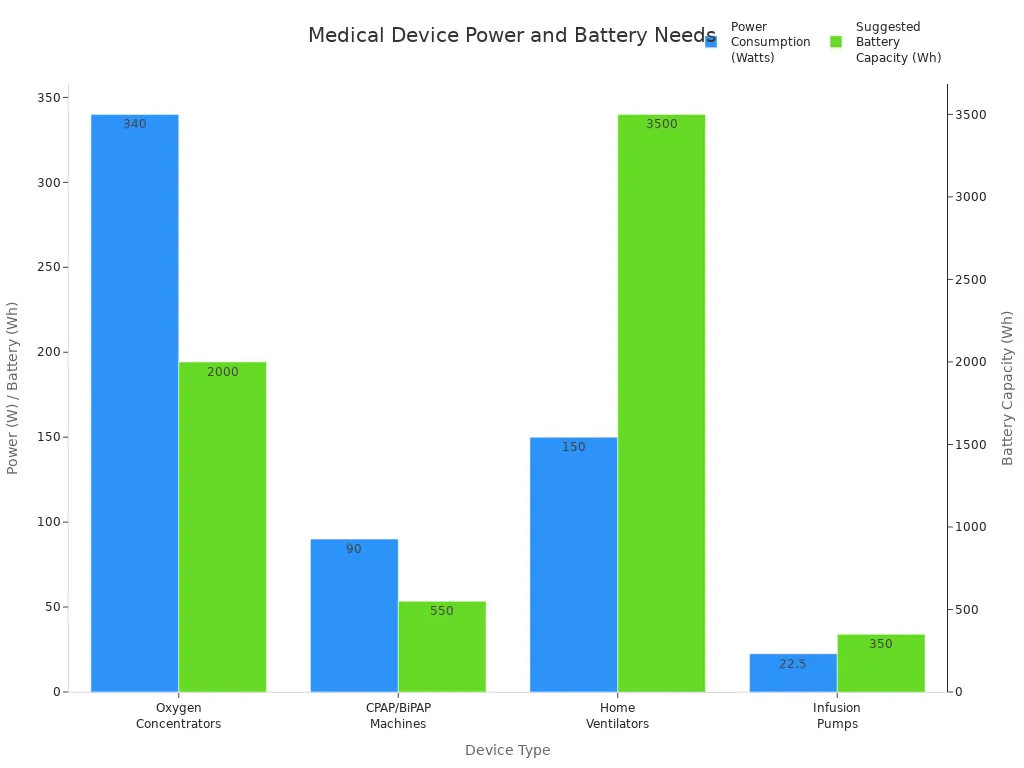
Note: For home and facility use, always size your backup battery based on device power needs and expected runtime. Use the formula: (Device Watts × Runtime Hours) × 1.25 (safety margin). For example, a 300W oxygen concentrator running for 10 hours requires at least 3,750Wh.
You can enhance sustainability and operational efficiency by choosing lithium battery packs with long cycle life and safe chemistry. This approach supports your organization’s commitment to sustainability and reliable patient care.
Emergency Backup
Emergency situations demand robust and reliable backup solutions. You must ensure that your oxygen therapy devices remain operational during power outages, natural disasters, or unexpected disruptions. Lithium battery packs designed for emergency backup offer advanced safety features and seamless power transitions.
100% output pure sine wave power delivers clean, stable electricity for sensitive oxygen concentrators.
Premium online double conversion UPS technology protects against surges and disturbances.
Uninterruptible Power Supply (UPS) function with automatic zero switch time ensures seamless power transition.
Surge protection safeguards expensive medical and industrial equipment.
Silent operation and solid-state cooling support use in hospitals, security systems, and infrastructure facilities.
Universal compatibility allows you to link multiple batteries for extended capacity, supporting longer emergency scenarios.
Fast recharge times and versatile charging options (wall, car, solar) increase readiness.
Lightweight and compact design improves portability for rapid deployment.
⚠️ Not all batteries are FAA/TSA compliant for air travel. Always verify compliance when planning for mobile emergency response.
You should prioritize lithium battery packs with built-in safety systems, surge protection, and the ability to expand capacity. These features are vital for medical, robotics, security system, infrastructure, consumer electronics, and industrial sectors where uninterrupted oxygen therapy can be life-saving.
By matching your battery pack selection to your specific oxygen needs—whether for travel, home, facility, or emergency use—you ensure operational continuity, regulatory compliance, and the highest standard of care.
Choosing the Best Portable Oxygen Concentrator
Key Selection Factors
When you evaluate the best portable oxygen concentrator for your organization, you must consider several critical factors. Portability stands out as a top priority. Ultra-lightweight units, some weighing as little as 0.84kg, make travel and home use easier for staff and patients. Compact models offer maximum mobility, which is essential for medical, robotics, and industrial applications. You should review battery life closely. Longer runtimes support extended shifts and reduce downtime, especially in infrastructure and security system settings.
Supplier reputation plays a major role in your buying guide. High review scores, such as those from Foshan Mic and Shenyang Aerti, indicate strong satisfaction among B2B customers. You should also assess product tiers and portable oxygen concentrator cost. Entry-level units may fit basic needs, while specialized models deliver advanced features for hospitals or eldercare. Integration of AI and IoT technologies can optimize device performance and environmental impact. You benefit from miniaturization, noise reduction, and adaptability to diverse use cases.
Tip: Expert recommendations suggest prioritizing lithium battery technology for durability, energy efficiency, and recyclability. These features help you meet operational demands and sustainability goals.
Regulatory Compliance
You must ensure every portable oxygen concentrator meets strict regulatory standards. Safety, energy efficiency, and recyclability are essential for compliance in medical, consumer electronics, and industrial sectors. You should verify certifications such as UN38.3 and IEC 62133 for lithium battery packs. FAA approval is necessary for travel applications. Environmental regulations drive manufacturers toward green technologies and advanced lithium battery chemistries like LiFePO4 and NMC.
Supplier transparency is vital. You need to confirm sourcing practices, especially regarding conflict minerals. Review the conflict minerals statement to ensure ethical sourcing and compliance with global standards. Expert recommendations highlight the importance of working with trusted manufacturers who maintain high regulatory and environmental standards.
Note: Regulatory compliance protects your organization from legal risks and supports safe, reliable oxygen therapy across all sectors.
You see that leading portable oxygen concentrator battery packs offer distinct advantages for B2B buyers across medical, robotics, security system, infrastructure, consumer electronics, and industrial sectors. The table below highlights key features for top models, helping you match battery packs to operational needs:
Model Group | Delivery Method | Weight Range | Battery Life (Pulse Dose) | FAA Approved | Warranty |
|---|---|---|---|---|---|
Inogen One Series & Mini | Pulse Dose | ~2.7–5 lbs | 2.25–13 hours | Yes | Up to 3 years |
SimplyGo, OxLife, Eclipse | Pulse & Continuous | 10–18 lbs | 2–5.75 hours | Yes | Up to 5 years |
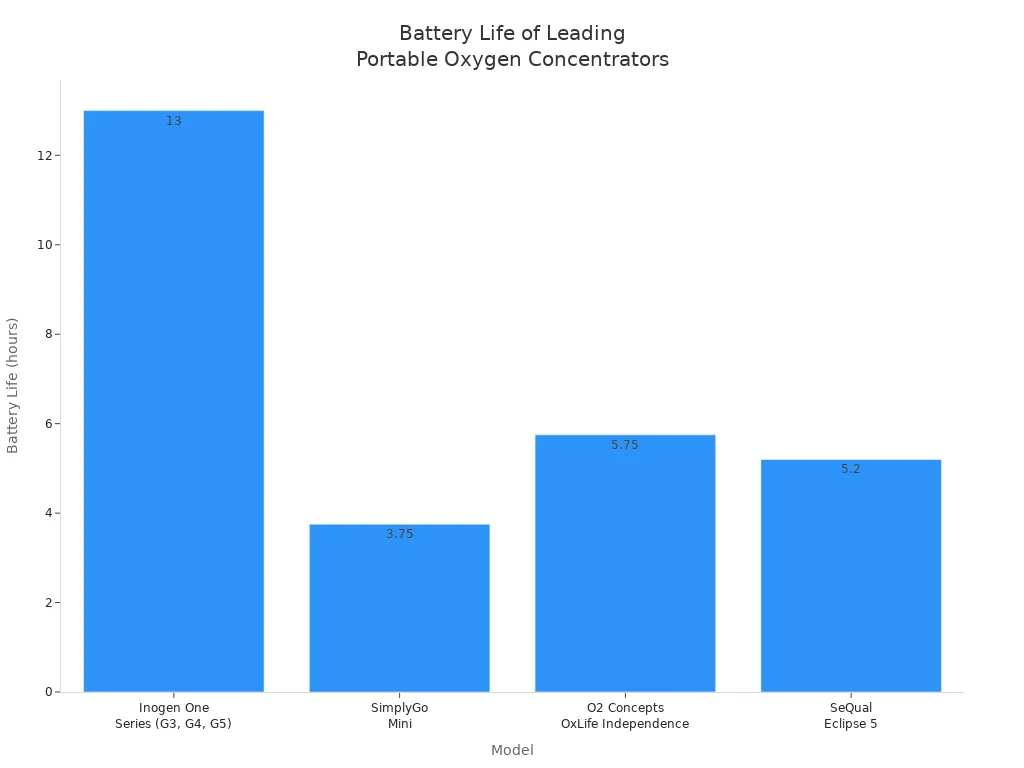
You should select battery packs with advanced lithium battery technology for longer runtime, lighter weight, and improved safety. Manufacturers provide strong warranty and support options, ensuring reliable oxygen therapy and ongoing assistance. Rapid advancements in lithium-ion batteries continue to boost mobility, efficiency, and sustainability, giving you confidence in future-ready solutions.
FAQ
How do you maximize lithium battery life in portable oxygen concentrators?
You should store batteries at 50% charge in a cool, dry place. Avoid extreme temperatures. Use only manufacturer-approved chargers. Regularly inspect for damage. For more on lithium battery care, see Nature’s battery guidelines.
Which lithium battery chemistries offer the best safety for medical and industrial use?
You benefit most from Lithium Iron Phosphate (LiFePO₄) and Nickel Manganese Cobalt Oxide (NMC) chemistries. These provide high thermal stability, long cycle life, and robust safety features. You find them widely used in medical, robotics, and infrastructure sectors.
Can you use portable oxygen concentrator battery packs in robotics and security systems?
You can deploy lithium battery packs in robotics and security systems. Their high energy density and reliability support continuous operation. You must verify compatibility and regulatory compliance for each application scenario.
What certifications should you look for in lithium battery packs for B2B procurement?
You should confirm UN38.3, IEC 62133, and FAA approval. These certifications ensure safety, transportability, and regulatory compliance in medical, industrial, and infrastructure sectors. Always request documentation from suppliers.
How do you safely dispose of used lithium battery packs?
You must recycle lithium batteries through certified programs. Tape terminals and bag batteries before drop-off. Never dispose of them in regular waste. Proper disposal protects your organization and the environment.




